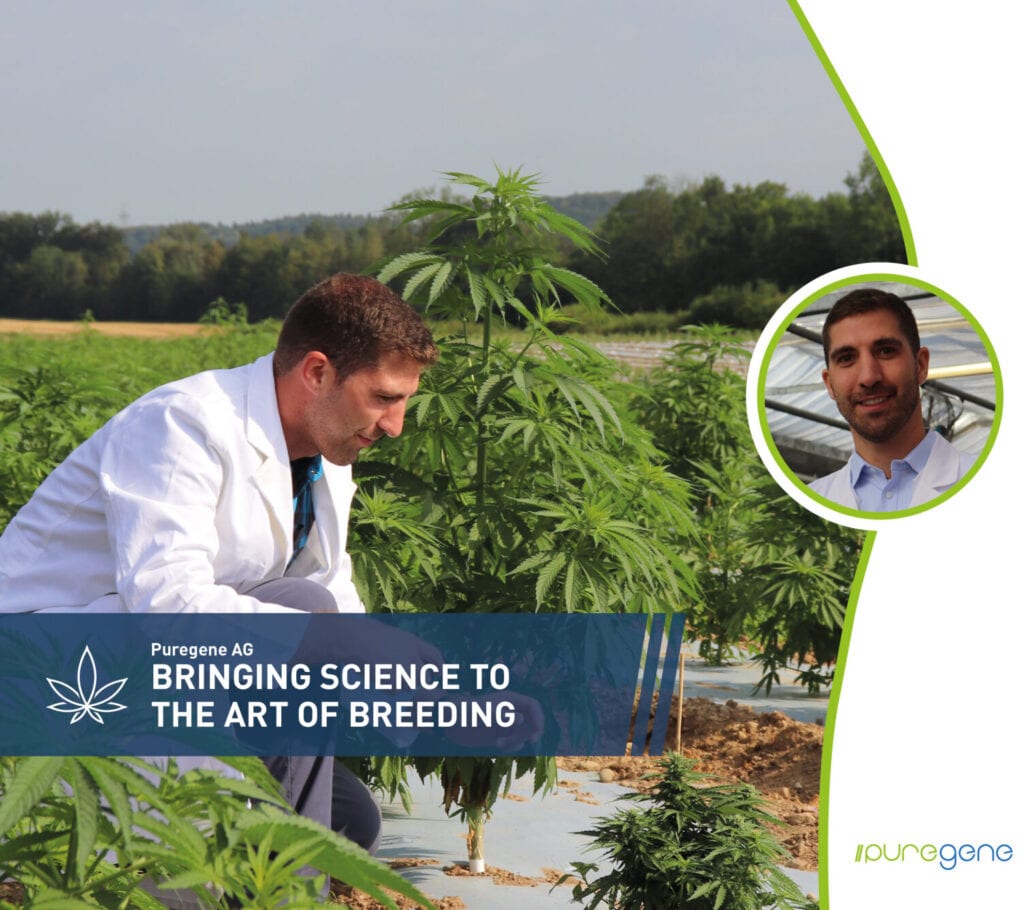Maximilian Vogt, Head Breeder at Puregene AG, and his team have created an extensive database over the past few months, in which each cannabis plant and its properties have been precisely recorded. In this interview he explains where the biggest challenges lie and what makes Puregene’s breeding program so special.
Maximilian Vogt, you have been working as Head Breeder for Puregene AG since June 2020. What is your main task at the moment?
MAXIMILIAN VOGT: Building up our database and evaluating our field trials. There were 20,000 plants in our CBD field and another 4,000 plants in the THC field. Our breeding program in Zeiningen was continuously running in parallel. Each plant had to be documented and was provided with an identification number and a QR code. This guaranteed that we knew exactly which plant had which characteristics and in which greenhouse or field was located. I coordinated and supervised the entire process.
So serious cannabis breeding is actually still in its infancy?
MV: Cannabis plants were grown in the cellar for a long time. Attention wasn’t paid to the genetic origin of the plants, except for industrial hemp – but this has little resemblance with medicinal hemp. These mostly illegal crosses have little to do with classic breeding programs like wheat, barley, or corn, which have been cultivated for thousands of years. Puregene is now the first to advance molecular breeding, which supports classical breeding immensely. We can now classify the plants in a breeding schematic.
Why is it so important to focus on both strands – molecular and classical breeding?
MV: Molecular breeding can take a lot of pressure off the breeder. With the tools from our laboratory, we can identify and sort out bad characteristics of the plant at the seedling stage. For example, if you want to avoid male plants in the field. This saves several weeks of work and ensures a higher quality of the final product.
What makes your work particularly attractive?
MV: The quality of Puregene’s genomic resources is outstanding, we have the best genome worldwide. That is why this work is so promising. In addition, Puregene has a high level of know-how represented by outstanding research staff.
For my work I need an extremely high genetic diversity in the breeding material. This allows us to contrast many different characteristics of the cannabis plant, evaluate them and select the populations that are particularly suitable for our research or breeding. I pass these measurable properties on to my colleagues in the laboratory, who can now search for the reasons in the genome and thus conduct targeted research. This is why the THC research we are allowed to do is also so important.
Can you further explain?
MV: Let me explain with an example. We can only work out the difference between THC and CBD plants, if we can study both types of plants. Historically, THC plants have been relatively far advanced by cellar breeding and have interesting characteristics that are far superior to CBD plants. Many THC-free plants are also genetically relatively unstable. As soon as we know the difference between plants containing THC and THC-free plants, we can backcross a THC-containing plant. The result will be a plant without THC, however with all the other positive traits and completely GMO-free.
So, the plants on your field will be mainly used for research?
MV: Our field trials were completely designed for research. But the beauty of cannabis is that I can take a plant that is particularly good and put it into our mother plant production at any time. Unlike many other crops, this is a shortcut in the breeding program.
Can you give a specific example?
MV: We search our material for interesting properties such as special cannabinoids. Then we define new breeding targets towards one of these new cannabinoids. We are then able to select plants during the pre-breeding stage. Finally, we re-grow that specific plant. This means: We start from scratch and breed new plants with our collected material.
You have mentioned being able to shorten processes with your methods. How much time can you actually save?
MV: Breeding a variety usually takes about 8 years. With our genetic tools, the characteristics of a cross or seedlings can be predicted. Above all, this molecular support helps us specifically search for rare combinations in thousands of seedlings simultaneously and not having to evaluate them through long-term field trials. In individual cases, this makes it possible to obtain a marketable plant directly. Generally, Puregene shortens the breeding period by 2-4 years.
Where was the biggest challenge for the field trials?
MV: Definitely in the organization and building of our database and as you can possibly imagine in harvesting and analyzing 20,000 individual plants by hand and one by one.
How big was your team?
MV: I had three employees that supported me in the field. About 10 to 15 people were involved in cloning. This was an important step, because by making copies of each individual plant we could create backups. The same group took on the tedious challenge of analyzing the diversity of all our wonderful plants.
Who benefits most from your work?
MV: Our goal is to sell traits and develop genetic tools that improve breeding. This means that especially breeders and producers who want to weed out unwanted traits or are looking for unique genetics will benefit. This leads to a more resistant harvest, higher yield, and therefore more profit.
Maximilian Vogt, a native of Ludwigsburg, completed his bachelor’s and master’s degrees in agricultural science and crop science at the Martin Luther University of Halle-Wittenberg. After completing his doctorate in collaboration with two German breeding companies and the ETH Zurich, he joined the Swiss company Puregene AG as Head Breeder in June 2020.
